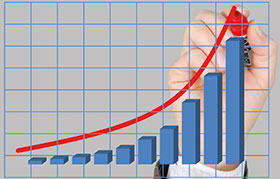

If the classic movie ‘The Graduate’ were written today, instead of ‘plastics’ as the key to future success, our young protagonist would hear one word: ‘sensors.’ It has become gospel that sensors will soon be at the heart of everything, with Business Intelligence sitting above analysing their data. Perhaps.
New technology can certainly be wonderful, but it’s most critical to have a deep understanding of one’s industry. The past two decades have seen a significant investment in sensors and analytics, made on the promise of clean and actionable data that is relevant to specific business processes. The sensor ecosystem is far from a homogenous market-space, which explains the significant confusion from authoritative sources in whitepapers, conferences and blog posts. There are horizontal and vertical plays being mixed together and IoT adds another layer of confusion. On top of that, we must distinguish between IoT, iot, IoE and IIoT.
Different industries, different economics
Looking at a specific example, the chemical processing and manufacturing market has been utilising sophisticated sensors since the late 1980s. There have been frequent attempts to layer the same approach over upstream oil and gas without any consideration as to whether it is appropriate for that context. Upstream O&G has a much different return curve associated with its assets than do chemical and manufacturing plants. Upstream has a drastically declining curve, which means the capex and operating model which are typically based on lease-operating expenses (LOE) must be kept low. Companies that have poured millions of dollars into scada systems for monitoring assets trying to follow the chemical and manufacturing approach have seen very little comparative value in return because of the decline curves associated with wells. The scada assets stick out like sore thumbs as the price per Barrel of Oil Equivalent (BOE) drops over time.
A different approach leads to success
This has prompted some organisations to try a different approach. We spoke to a mid-market company that prototyped a Machine Learning solution in conjunction with experienced field personnel and front-line engineers to improve uptime, predict maintenance challenges and increase throughput for a client’s field of electric submersible pumps (ESPs). The prototype’s outcomes changed the way the ESPs were operated, reducing costs and significantly increasing each well’s production by optimising operating parameters using the existing control systems. The vendor was able to price based on a cost per ESP, instead of a standard licensing deal. Their client quit entertaining new analytics vendors with the latest interactive graphs to focus on supporting their existing systems, which were now being fed smarter information based on predictive models developed with subject matter experts. [Note: This vendor solution was provided by OspreyData – and in full disclosure, I’m on the Board of Directors].
Why haven’t more IoT companies combined sensor data with machine learning and existing human expertise under an economic LOE model to match their target industries? The reason is that sophistication in Data Collection and Data Science and the application of that information to industrial data science is weak in the market today. These missing technologies are what is needed if IoT and especially Industrial IoT is to flourish. Everyone talks blithely about a $30B, or even $40B IIoT market by 2020, but without a new-paradigm solution, what we are really talking about could be little more than marketing hyperbole, instead of profitable reality.
Moving from scada and BI to physical systems intelligence
There is already massive demand for M2M intelligence and its ability to connect physical systems and share real-time data among users. This is not terribly new (though check out SWARM Engineering for a novel approach to this) but more critically, what is done with the data has not changed for many years. The 1990s saw the emergence of Business Intelligence tools like Cognos, Crystal Decisions, BusinessObjects and others. These gave IT a post-mortem view of the data and its historical relevance. In the years that followed, we saw an explosion of technologies to enable business users to format, analyse, forecast and plan. We began to see the deployment of vast computing power to end-users, a trend that has gathered pace recently. But are these tools capable of tapping into the value of the astronomically Big Data physical sensors will provide?
My belief is that Business Intelligence must evolve into something I call Physical Systems Intelligence (PSI). PSI combines Machine Learning done on physical sensor data with human intelligence and intuition to allow organisations to learn from their subject matter experts and field operators along with their industrial devices and machines. The augmentation of expert human knowledge with embedded machine-learning systems is where IoT systems must go. This initiative follows legitimate research around AI, Machine Learning, Deep Learning, Reinforcement Learning, Expert Skill Acquisition, Intuition vs Rationalisation (Hubert & Stuart Dreyfus, et al.) Interestingly, the list of buzzwords surrounding this topic seems much longer than the list of first-rate and validated tools that move us from BI to PSI.
Why is PSI different?
Optimising industrial systems requires the creation and maintenance of many complex predictive models, and modern AI has only recently caught up with the explosion of sensor data. Traditional techniques, using general purpose modelling tools, or trying to convert BI tools and programming languages to solve the IIoT challenges, simply does not work. As I write this, TV is awash with ads for the movie ‘Deepwater Horizon’, a sobering reminder of what can happen if you have the sensors and data but not enough real-time and actionable information that has learned the consequences of certain states and conditions.
No matter what industry you are in, IIoT will be a powerful reality. The edge – the sustainable competitive advantage – will go to those organisations and individuals who can adopt PSI successfully, which means they must:
1. Integrate expert human knowledge with Big Data analytics. Firms that can do this are grabbing control of niches (e.g., Proskriptive in healthcare).
2. Capture and use deep industry knowledge. What are industry-specific economics? What are the triggers that may alter the environment? What semantic meaning does this data possess?
3. Execute effectively in the field. The DevOps movement tells us that there is often a surprisingly steep learning curve for implementing tools that integrate across complex elements. In another article, I will look at how DevOps is evolving, and what you can do to accelerate this.
Yes, the one word for the future may be ‘sensors’, but the race will be won by the organisations and individuals who can move from Basic Monitoring Systems to Physical Systems Intelligence, where applications can prescribe and predict humans to act in a deliberate manner to resolve and optimise operations and performance and embrace the human-focused actions in the three points above.
Miles Mahoney

Miles Mahoney is a successful entrepreneur and venture investor with a portfolio of investments into companies that solve problems for large industrial firms focused on Artificial Intelligence, Big Data and Analytics and Machine Learning. He has over 25 years of experience leading software companies through various stages of growth. Before joining Frost Data Capital, Miles was CEO and Founder of Invest Idaho Innovation, a foreign investment fund focused on technology and innovation. He has a BA in Finance from Montana State University, and an MBA from Grazadio School of Management, Pepperdine. Miles can be contacted at [email protected].

© Technews Publishing (Pty) Ltd | All Rights Reserved